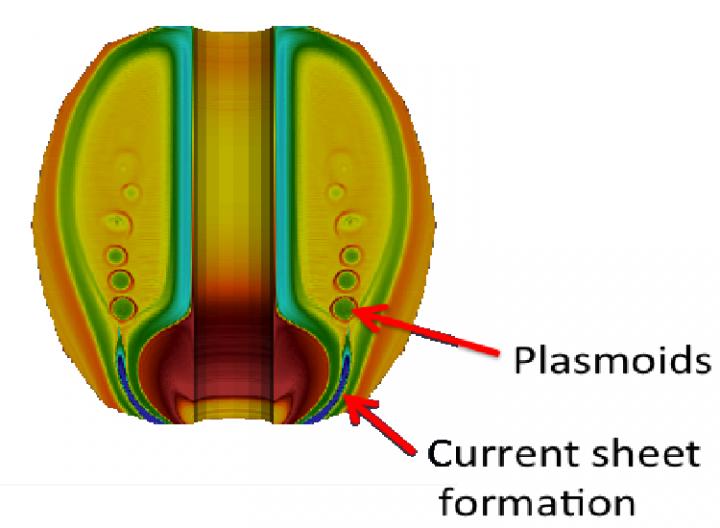PPPL physicist uncovers clues to mechanism behind magnetic reconnection

Current sheets and plasmoids are formed during the simulation of a process called coaxial helicity injection, which could produce effective startup current-drive in spherical tokamaks. Credit: Fatima Ebrahimi
That plasma can eventually interact with magnetic fields surrounding the Earth, endangering communications networks and power systems. In fusion facilities, reconnection can help start and confine the plasma that fuels fusion reactions. This research was funded by the DOE's Office of Science (Fusion Energy Sciences) and was published in the December issue of Physics of Plasmas.
Using a computer code developed by researchers at universities and fusion labs, Ebrahimi simulated plasma circulating within a vessel shaped like a doughnut. The vessel mimicked the doughnut shape of fusion facilities called tokamaks. The simulated facility had an opening in its floor for physicists to inject magnetic field lines that would balloon in the tokamak's interior and initiate the fusion process.
Reconnection occurred in the following way. The field lines forming the balloon created an electric current that produced three-dimensional wiggles and wobbles that pushed the open end of the balloon until it closed. At that point, magnetic reconnection occurred and turned the magnetic balloon into a magnetic bubble called a plasmoid that carries electric current.
Ebrahimi is now expanding that research. She is currently looking into how to harness the current to create and confine a fusion plasma without using a large central magnet called a solenoid.
Different conditions can set off the reconnection process. “If the strength of the field lines associated with the original magnetic balloon is not enough on its own to instigate reconnection,” Ebrahimi said, “the secondary magnetic wiggles can amplify the magnetic fields at the reconnection site, triggering the event.” She is also investigating the amplification of magnetic fields through these secondary three-dimensional magnetic and fluid wiggles known as the dynamo effect.
These findings on the effect of magnetic fields can have a broad impact. “The analysis and the modeling can help us better understand how the reconnection process that is triggered by magnetic perturbations in plasmas can lead to the detachment of magnetic loops on the surface of the sun, or efficient startup for fusion plasmas,” Ebrahimi said.
###
PPPL, on Princeton University's Forrestal Campus in Plainsboro, N.J., is devoted to creating new knowledge about the physics of plasmas — ultra-hot, charged gases — and to developing practical solutions for the creation of fusion energy. The Laboratory is managed by the University for the U.S. Department of Energy's Office of Science, which is the largest single supporter of basic research in the physical sciences in the United States, and is working to address some of the most pressing challenges of our time. For more information, please visit science.energy.gov.
Media Contact
All latest news from the category: Physics and Astronomy
This area deals with the fundamental laws and building blocks of nature and how they interact, the properties and the behavior of matter, and research into space and time and their structures.
innovations-report provides in-depth reports and articles on subjects such as astrophysics, laser technologies, nuclear, quantum, particle and solid-state physics, nanotechnologies, planetary research and findings (Mars, Venus) and developments related to the Hubble Telescope.
Newest articles

Properties of new materials for microchips
… can now be measured well. Reseachers of Delft University of Technology demonstrated measuring performance properties of ultrathin silicon membranes. Making ever smaller and more powerful chips requires new ultrathin…

Floating solar’s potential
… to support sustainable development by addressing climate, water, and energy goals holistically. A new study published this week in Nature Energy raises the potential for floating solar photovoltaics (FPV)…

Skyrmions move at record speeds
… a step towards the computing of the future. An international research team led by scientists from the CNRS1 has discovered that the magnetic nanobubbles2 known as skyrmions can be…





















